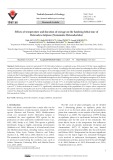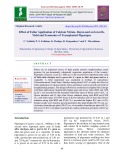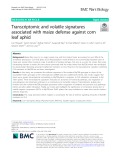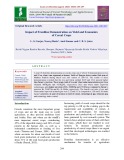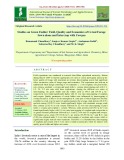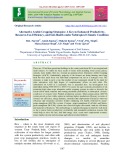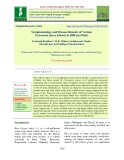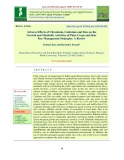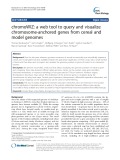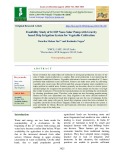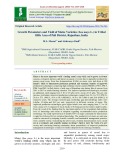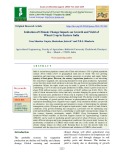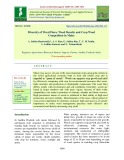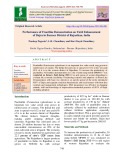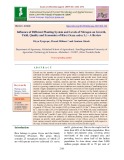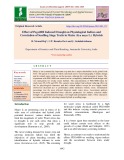
Economics of cereal crops
-
Mediterranean cereal cyst nematode (CCN) Heterodera latipons is considered as one of the main CCN that causes significant economic losses in the production of intolerant cereal crops in Turkey. Accordingly, this study aimed at evaluating the effect of different storing temperatures and durations on the emergence of second-stage juveniles (J2s) of the nematode populations obtained from the eastern Mediterranean (Adana and Hatay) and south-eastern (Gaziantep and Kilis) regions of Turkey. The obtained results revealed a variation in the J2s hatching profiles of the regional nematode populations.
 10p
10p  dolomite36
dolomite36
 30-12-2021
30-12-2021
 16
16
 0
0
 Download
Download
-
Pulses are an important source of high quality protein complementing cereal proteins for pre-dominantly substantial vegetarian population of the country. Pigeonpea (Cajanus cajan (L.) Mill sp.) is the second most important pulse crop of India after chickpea and is grown for it’s grain as dhal and green seed as a vegetable. A field experiment was conducted at College of Agriculture, Vishweshwaraiah Canal Farm, Mandya during kharif 2017 to study the effect of foliar application of calcium nitrate, boron and humic acid on growth and yield of transplanted pigeonpea.
 11p
11p  chauchaungayxua12
chauchaungayxua12
 29-07-2021
29-07-2021
 13
13
 1
1
 Download
Download
-
Maize (Zea mays L.) is a major cereal crop, with the United States accounting for over 40% of the worldwide production. Corn leaf aphid [CLA; Rhopalosiphum maidis (Fitch)] is an economically important pest of maize and several other monocot crops. In addition to feeding damage, CLA acts as a vector for viruses that cause devastating diseases in maize.
 15p
15p  vijichea2711
vijichea2711
 28-05-2021
28-05-2021
 8
8
 1
1
 Download
Download
-
A total 26 frontline demonstration on cereals crops out of which 16 demonstration on rice and 10 on wheat were organized at farmers’ fields of Sheopur district under Gird zone of Madhya Pradesh during kharif and rabi season of 2014-15. The results of these demonstrations revealed that the rice and wheat yielded 10.07 and 12.14 percent higher than farmer’s practices.
 4p
4p  trinhthamhodang11
trinhthamhodang11
 27-04-2021
27-04-2021
 9
9
 1
1
 Download
Download
-
Field experiment was conducted at research farm Bihar agricultural university, Sabour during Kharif -2019 to find the appropriate row ratio of cereal and legume intercrop for better quality of forage with maximum net returns. Intercropping system had significant effect on nutritive value of forage crops and economics.
 10p
10p  chauchaungayxua11
chauchaungayxua11
 23-03-2021
23-03-2021
 14
14
 2
2
 Download
Download
-
The strategies is made in such a way that product of one component should be the input for other enterprises with high degree of complimentary effects on each other. The information on AACS in a systematic way is presented here. An investigation was undertaken during 2010–20111 to 2014-15 to assess the agro-economic potentiality of ten promising high-value crops alternative arable cropping systems in order to diversify the cereal–cereal based rotations and owning maximum profitability in subtropical climatic condition of western Uttar Pradesh production systems...
 19p
19p  cothumenhmong9
cothumenhmong9
 18-01-2021
18-01-2021
 11
11
 2
2
 Download
Download
-
The basic aim of the investigation was to screen the potential of Trichoderma harzianum for bio suppression of Rhizoctonia solani f. sp. sassaki, the causal agent of banded leaf and sheath blight of maize which is one of the most destructive diseases of Bihar. The disease severity ranging from 30.30 to 80.46 per cent and gaining the economic importance now a day. Maize (Zea mays L.) is one of the most important cereal crops in the world agricultural economy as food, feed and industrial products. It is a miracle C4 crop and has a very high yield potential.
 5p
5p  gaocaolon9
gaocaolon9
 22-12-2020
22-12-2020
 15
15
 1
1
 Download
Download
-
Rice (Oryza sativa L.) is an important cereal crop and prone to many diseases out ofwhich, rice blast caused by Pyricularia grisea is of significant economic importance due to its destructive nature leading to serious yield loss. Blast infected leaves of rice, Panicum grass and finger millet were collected from different fields of OUAT farm, Bhubaneswar.
 6p
6p  angicungduoc6
angicungduoc6
 22-07-2020
22-07-2020
 17
17
 2
2
 Download
Download
-
Pulse crops are an integral part of Indian agricultural economy next to the cereals and oilseeds in terms of production, productivity and economic value. These crops are richest source of protein and energy but in India such crops are largely cultivated under energy starved and polluted conditions, resulting affecting the metabolic activity and limiting the yield. Agricultural soil contaminated by heavy metals becomes a severe environmental issue in this day due to its potential adverse ecological effects.
 16p
16p  angicungduoc6
angicungduoc6
 22-07-2020
22-07-2020
 14
14
 2
2
 Download
Download
-
Potato (Solanum tuberosum L.) is a cool season vegetable, grown throughout the world. It is said to be the native of Peru in South America. It is an important tuber crops grown extensively throughout India as well as the world. It is an annual, herbaceous, dicotyledonous and vegetative propagated plant. Potato is high nutrient demanding crop due to underdeveloped and shallow root system.
 6p
6p  caygaocaolon5
caygaocaolon5
 27-05-2020
27-05-2020
 9
9
 0
0
 Download
Download
-
ChromoWIZ: A web tool to query and visualize chromosome-anchored genes from cereal and model genomes
Over the last years reference genome sequences of several economically and scientifically important cereals and model plants became available. Despite the agricultural significance of these crops only a small number of tools exist that allow users to inspect and visualize the genomic position of genes of interest in an interactive manner.
 9p
9p  viminato2711
viminato2711
 22-05-2020
22-05-2020
 13
13
 1
1
 Download
Download
-
Green revolution has made India self-sufficient in food grain production. In most of the state of India cereal production is a surplus. But cereal production is not improving the economical condition of farmers. Vegetable cultivation is however considered as 2-3 times profitable than traditional cereal cultivation. Farmers can make more profit by cultivating vegetable after cereal crops. But in Rabi and Zaid seasons irrigation water availability is a major problem in rainfed areas.
 9p
9p  nguaconbaynhay5
nguaconbaynhay5
 11-05-2020
11-05-2020
 10
10
 0
0
 Download
Download
-
Maize is the most important world‟s leading cereals crop which can be grown in diverse seasons, ecological and uses and known as queen of cereal due to unparallel productivity among cereal crops. Front line demonstrations (FLDs) on maize were laid down at 180 farmers‟ fields to demonstrate production potential and economic benefits of improved production technologies comprising high yielding varieties namely PEHM-2, PM-3, PM-5, PSM 2 and PM 4 in Pali district of arid zone of Rajasthan state during Kharif seasons from 2011 to 2017 in rainfed farming situation.
 10p
10p  nguathienthan4
nguathienthan4
 18-04-2020
18-04-2020
 12
12
 1
1
 Download
Download
-
India is second most populous country after China which houses 15% of global population (census 2011) within 2.42% of geographical land area of world. The ever growing population and improving economic condition pressurize to produce and supply higher quantity of food grains. However, the country’s agriculture production is not increasing but somewhere stagnated, this increasing demand for food grain production. Agriculture sector therefore needs much attention to decrease this gap between increasing demand and production. Wheat, the staple cereal crop in world, is grown in 220.
 13p
13p  kethamoi4
kethamoi4
 16-04-2020
16-04-2020
 5
5
 0
0
 Download
Download
-
Wheat (Triticum aestivum L.) is an important constituents of Indian agriculture and nutritional security due to their high yield, economic viability, ability to generate on-farm and off-farm employment so this makes it one of the most important cereal crops in India and a main source of vitamins and minerals such as thiamine, niacin, iron, riboflavin, vitamin D, calcium, and fiber. Wheat covers approximately 25% of the total global area devoted to by cereal crops. Since the consumption of wheat is directly proportional to the population growth.
 5p
5p  trinhthamhodang1212
trinhthamhodang1212
 06-04-2020
06-04-2020
 14
14
 0
0
 Download
Download
-
Rice (Oryza sativa L.) and Wheat (Triticum aestivum L.) are important constituents of Indian agriculture and nutritional security due to their high yield, economic viability, ability to generate on-farm and off-farm employment so this makes it one of the most important cereal crops in India main source of vitamins and minerals such as thiamine, niacin, iron, riboflavin, vitamin D, calcium, and fiber.
 14p
14p  chauchaungayxua3
chauchaungayxua3
 07-02-2020
07-02-2020
 18
18
 0
0
 Download
Download
-
Maize (zea mays l.) Is one of the most important crops among the cereals in the world agricultural economy both as food and fodder crop and is regarded as “queen of cereals”. Weeds can suppress crop growth and yield by effectively competing with crop for environmental resources like water, light, nutrients and production of allelopathic compounds. The weed flora differs widely with environment and soil conditions. Generally, weeds are found in larger numbers and with more vigour, because of their wider adaptability even under extremities of climatic, edaphic and biotic stresses.
 12p
12p  nguaconbaynhay3
nguaconbaynhay3
 07-02-2020
07-02-2020
 12
12
 0
0
 Download
Download
-
Pearlmillet (Pennisetum typhoideum) is an important low value cereal crop grown in rainfed areas of country. The Indian hot arid zone is spread over 0.32 m km2 area and 65% of it is in the western district of Rajasthan.
 4p
4p  kethamoi2
kethamoi2
 15-12-2019
15-12-2019
 7
7
 0
0
 Download
Download
-
Cereals are the member of grasses, which belong to family Gramineae (Poaceae) and cultivated for edible components of their grain which is composed of the endosperm, germ and bran. Cereal grains are grown in greater quantities and provide more food energy worldwide than any other type of crop. In their natural form, they are a rich source of carbohydrates, protein, vitamins, minerals and fats. The green revolution of the 1970s resulted in remarkable increases in rice production. Since then the rate of production in most rice growing countries has slowed and has now reached a plateau.
 12p
12p  nguaconbaynhay1
nguaconbaynhay1
 04-12-2019
04-12-2019
 14
14
 1
1
 Download
Download
-
Maize is an economically important crop and also a major shareholder in the global food bowl. The queen of cereals is widely cultivated across varied topography. Climate change and its related water stress are on the increase, reducing the yield potential of maize. The experiment with PEG-6000 was carried out in a completely randomized block design with two replications for twenty maize hybrids. The concentrations of PEG-6000 taken for study were 0%, 10% and 20%.
 4p
4p  nguaconbaynhay1
nguaconbaynhay1
 04-12-2019
04-12-2019
 19
19
 1
1
 Download
Download
CHỦ ĐỀ BẠN MUỐN TÌM









